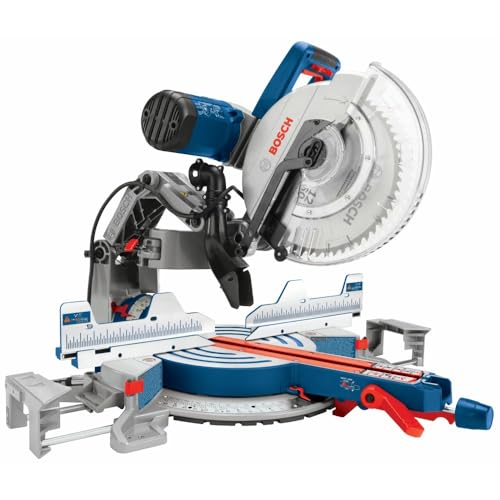You’ve come to the right place if you’re having trouble understanding the differences between a compound vs sliding miter saw.






In the case of miter saws, there are several options. So many that deciding which one is suitable for you can be overwhelming.
Differences Between Compound vs Sliding Miter Saw
Despite the fact that these two tools have a number of similarities, there is a significant difference between them.
Compound saws with their own set of advantages. Nothing blocks the cutting arm because they don’t have rails. As a result, they’re best suited to thicker materials.
The blade of a sliding miter saw can move back and forth on rails over large chunks of materials. They can chop materials that a compound miter saw’s blade can’t reach.
Let’s go through some basics of miter saws before delving deeper into both the saws.
Miter Saw: Basic Overview
Let’s have a quick peek at what a regular miter saw does before we get into the particulars of the compound and sliding miter saws.
A miter saw is mostly used to perform angled crosscuts. Certain models allow you to cut at any angle you like, even down to a select degree, whereas others are set to cut at the most common angles, such as 15, 30, and 45 degrees.
After you’ve determined the angle, you’ll need to hold the item against a barrier to keep it straight for a precise, clean cut. The circular blade is moved down and across the item in one, smooth motion to perform the cut.
Uses Of Compound vs Sliding Miter Saw
Compound Miter Saw
It should be easier to understand that a compound miter saw is a different tool now that you know a bit more about a basic miter saw.
Compound miter saws are more advanced and do more than basic miter cuts. With one exception, they operate in a similar manner as a regular miter saw.
A pivoting arm with the blade may be kept at an angle different than 90 degrees. As a result, in addition to miter cuts, you can also make bevel cuts.
What’s the reason for using a compound miter saw instead of a regular miter saw? Simply because of its adaptability. The possibility of doing bevel cuts greatly increases the scope of projects that can be undertaken.
Miter cuts are used to join two pieces together. Take a look at a photo frame. Due to the miter cuts of 45 degrees at the end of each side, the corners come together to form a perfect 90-degree angle.
Bevel Cuts
So, what makes the bevel cut unique? The bevel cut gets through the thick item rather than staying across the face of the material.
Another way to look at it is as follows. A bevel cut is made through the vertical plane, whereas a miter cut is done by keeping it at an angle to the horizontal plane.
Bevel cuts are commonly used for finishing, but they may also be used to cut crown molding or for a different project that involves making angled cuts in both the horizontal and vertical planes.
That’s not everything, though. Compound saws come in different variations. A blade on a typical compound miter saw can only tilt in a single direction: right or left.
That means you’ll have to manually turn the item around and work on it from the opposite side if you need to make a cut in the other direction.
Constantly shifting the material will become tiresome if you use this cut regularly. A dual compound miter saw is another alternative, which is comprised of a blade that moves both right and left.
However, this isn’t a saw that everybody needs. But if you perform many jobs that need both bevel and miter cuts, it’ll come in handy.
Sliding Miter Saw
A sliding miter saw is comparable to a compound saw and can perform bevel and miter cuts as well. The main distinction is the material width they can manage.
This distinction can be summed up in a single phrase: sliding.
A sliding miter saw can perform all of the functions of a compound miter saw, but it also comes with rails that let you move the saw back and forth. This greatly improves cutting ability by allowing you to make cuts on thicker pieces.
Compound Sliding Miter Saw
A compound sliding miter saw combines the best features of both types of miter saws.
This miter saw adds a left bevel to facilitate compound cuts and employs rails to boost cross-cut capacity. You have the versatility of a compound miter saw plus the increased depth of cut provided by the slide in this option.
If you need to cut thicker material, such as 1×12 lumber, this is the tool to get.
If you’re looking for a more portable and compact saw, skip this one.
Benefits & Drawbacks Of Compound vs Sliding Miter Saw
Compound Miter Saw
A compound miter saw has a larger cutting arc, which is one of its benefits. Because it doesn’t have rails, there is more usable height.
It can cut thicker pieces of material compared to a sliding miter saw with a blade of the same size. The most popular blade sizes are 10-inch and 12′-inch, with the variations explained here.
If you’re working on anything that needs thicker material, a compound miter saw is a better choice than a sliding miter saw.
Compound miter saws don’t take up a lot of space. If you don’t have enough room in your worksite, a compound miter saw is the way to go.
A compound miter saw is often less expensive considering all other factors are equal. A compound miter saw is a better option if you’re concerned about the budget.
If you start doing projects that need large pieces of wood, the only drawback of having this form of saw instead of a sliding model is that it is more expensive. This is why it’s important to know what type of projects you’ll be working on prior to going out shopping.
Sliding Miter Saw
Siding miter saws are made to cut completely through large pieces of material without the need for repositioning anything. A sliding miter saw is the best way to go if you’re handling a project that involves cutting bevels and minters into large boards.
On the other hand, they are usually more expensive. If you think that you’ll need it, it’s well worth the extra cost. But if you’re not sure what type of work you’ll be performing, a sliding miter saw may not be essential.
Another drawback of sliding miter saws is that they need significantly more room than compound miter saws. Sliders simply need more space to function because their design requires back-and-forth movement.
Conclusion
So, is a sliding miter saw better?
It’s difficult to determine which kind of miter saw to buy before you know what type of projects you’ll be dealing with. This is because the size of the item that these two miter saws can handle is the main difference between them.
The next factor to think about is the cost. A high-end model of a sliding miter saw is significantly more expensive compared to a compound miter saw.
A compound miter saw is all you’ll need if the majority of your projects include making photo frames or cutting moldings and baseboards to size.
If you’re working with material that’s 8 inches wide or more, you’ll need a sliding miter saw for fast and reliable performance. If you need the best of both worlds, go for sliding compound miter saws.
Another aspect to consider is the amount of space available. Sliding miter saws are larger and heavier, requiring more room to work with.
In general, they should be held in a stable position. But, if you’re a trades professional who is constantly on the run, it might be a good idea to get a miter saw stand.
A compound miter saw is much easier to maneuver around in your worksite. It also provides you with the ability to bring your tool out in the yard or to the driveway to work. A cordless miter saw is recommended If you like to have a portable option.
We understand that making these choices can be difficult, and we’re here to assist you. Hope this article has shed some light on choosing between a compound or sliding miter saw for your next project.
